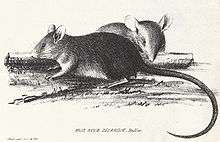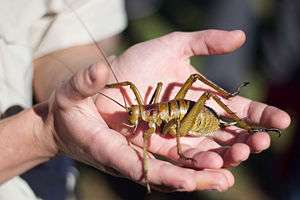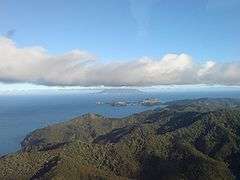Deinacrida heteracantha
Deinacrida heteracantha, also known as the Little Barrier giant wētā or wētāpunga (Maori: wētāpunga),[2] is a wētā in the order Orthoptera and family Anostostomatidae. It is endemic to New Zealand, where it survived only on Little Barrier Island, although it has been translocated to some other predator-free island conservation areas. This very large flightless wētā mainly feeds at night, but is also active during the day, when it can be found above ground in vegetation. It has been classified as vulnerable by the IUCN due to ongoing population declines and restricted distribution.
| Deinacrida heteracantha | |
|---|---|
_Holotype_specimen_from_the_Auckland_Museum.jpg) | |
| Scientific classification | |
| Kingdom: | Animalia |
| Phylum: | Arthropoda |
| Class: | Insecta |
| Order: | Orthoptera |
| Suborder: | Ensifera |
| Family: | Anostostomatidae |
| Genus: | Deinacrida |
| Species: | D. heteracantha |
| Binomial name | |
| Deinacrida heteracantha White, 1842 | |
Description
D. heteracantha can weigh up to 70 g, but on average weighs between 9–35 g. Average body length is around 75 mm (3 inches).[3][4][5] It is a sexually dimorphic species, with the females being much larger than the males. These large wētā have a broad body and a round head, along with short mandibles.[4] Compared to other cricket species wētā have relatively short antennae, but can deliver a strong kick with their hind legs. They are generally wingless.[3] The species is mainly herbivorous and feeds on forest foliage.[4]
Habitat
D. heteracantha are arboreal forest insect dwellers found on Little Barrier Island which lies off the coast of New Zealand. This island is only 3,083 hectares (7,620 acres) in size.[4] They once occupied forests in northern New Zealand including Northland and Auckland.[5] Their habitat range on Little Barrier Island is from second-growth forests located on the lower slopes of the island to the mid-level tall kauri forest.[4] The second-growth forest is dominated by silverfern, nikau palm, mahoe, and kohekohe.[5]
Behaviour
As adults these giant wētā live a nomadic lifestyle.[4] This type of lifestyle means that these wētā do not live in the same place, but move to a new location periodically.[6] They live a solitary lifestyle and most of their activity is done at night (i.e. feeding and moving).[5] They can be found above ground level under loose bark or in the cavities of mahoe and pohutukawa trees.[4] During the day and night males tend to move farther than the females. The male would follow the female by staying back about 25 cm from her; this is observed during the night time.[5]
Life cycle and reproduction
The life cycle of D. heteracantha is not tied to the seasons. They can live for up to two years. Eggs are laid in the summer months from October to December. The eggs will then hatch in March and April of the following year. D. heteracantha mate most months out of the year except for the winter months from June–August. Copulation will start in the morning and continue throughout the day. During copulation the spermatophore from the male is inserted into the female's subgenital plate. Females lay their eggs at night into moist soil. Each egg is laid singly or in groups of five in area that is about 15 cm2 and about 2–3 cm deep. Females only produce an indefinite amount of eggs. Females lay eggs for the rest of their lives, but only a limited number of them are fertilised during each copulation. The eggs incubate on average for 125 days and only 36% of the eggs survive to hatch.[7]
After the eggs hatch there are ten instars that they go through until death. In females the ovipositor becomes visible at the third instar. At the sixth instar the difference between male and female sexes becomes obvious. Each instar lasts on average between five and six weeks. D. heteracantha has an extra instar compared to other species in its genus, this extra instar is what makes the nymphal period longer and their overall body size larger.[7]
D. heteracantha show no courtship rituals. No stridulatory signals have been observed; sex recognition is done by contact only.[7]
Sound generation
D. heteracantha possesses a stridulatory apparatus. This apparatus is the sound producing organ based on the mechanism of rubbing one body part against another body part.[3] There is a great variety in these structures seen in Orthoptera. Certain behaviours are associated with the sounds being produced by the Orthoptera.[8] In the case of D. heteracantha there is a wide variation in the gross morphology of their stridulatory structures. Their stridulation plays a role in interspecific defense mechanisms. They use a femoro-abdominal mechanism to produce sound. This mechanism has two parts to it, a femoral peg and an abdominal ridge. The femoral pegs are an elongated and raised structure. There are two abdominal ridges present on D. heteracantha, a major and minor ridge. The major ridge is longer and higher than the minor ridge. The minor ridge does not normally come in contact with the femoral pegs. D. heteracantha has a wide-band linear magnitude spectra (kHz) that they produce for defensive sounds. They have a major peak at 20 kHz and a minor peak around 40–50 kHz. The shape of their stridulatory mechanism is why they can produce these frequency ranges.[9]
Threats

While D. heteracantha were commonly seen on Little Barrier Island in the 1950s, numbers have declined strongly since then. Predation rather than habitat destruction is regarded as the main cause for this.[10] Feral cats were present on the island until they were completely eradicated in the 1980s,[4] and may have fed on vulnerable juvenile D. heteracantha.[7]
Polynesian rats (Rattus exulans), "kiore" in Māori language, are one of the top predators of D. heteracantha, preying mostly on juveniles wētās which they kill during the night. An increase of the Polynesian rat population occurred after the feral cats were eradicated. As saddlebacks prey on the wētā during the day, D. heteracantha are thus under constant predation pressure.[10] There is evidence suggesting that these rats have a negative impact on the population of these wētā, as is commonly the case with invasive rodents.[11] The removal of the kiore in 2004 was a success. The population size grew back each year and a four-fold increase was reported six years after the removal.[12]
Other predators include tuatara, geckos and the North Island brown kiwi during the night, and kingfishers and the long-tailed cuckoo by day.[7]
Captive breeding and release

D. heteracantha is currently classified as vulnerable by the IUCN.[1] Since 2008 the Department of Conservation has been involved in a captive breeding and release programme to mitigate the risk of having the entire population resident on one island. Individuals captured on Hauturu/Little Barrier Island have been successfully bred in captivity at Butterfly Creek and Auckland Zoo. The descendants have been released onto Motuora and Tiritiri Matangi Islands. Additionally adults from Hauturu/Little Barrier Island have been transferred directly to Motuora. It is hoped that the released D. heteracantha will eventually build up self-sustaining populations on these additional predator free islands. In 2016 adult female has been observed on Tiritiri Matangi Island in the area where the first population was released. She can only be a descendant of the initial translocated population of 25 individuals released in 2011.[13] Individuals translocated onto Tiritiri Matangi island in 2014 have been observed mating.[14]
See also
References
- World Conservation Monitoring Centre (1996). "Deinacrida heteracantha". IUCN Red List of Threatened Species. 1996: e.T6305A12602299. doi:10.2305/IUCN.UK.1996.RLTS.T6305A12602299.en.
- "Giant Wētā/Wētāpunga". New Zealand Department of Conservation. Retrieved 17 Jan 2019.
- Nasrecki, P. 2013. Grasshoppers and their relatives. Elsevier Inc. 3: 247-264.
- Field, L.H. 2001. The Biology of Wetas, King Crickets and their Allies. New York: CABI Publishing.
- Thornburrow, Danny; Watts, Corinne (2011). "Habitat use, Behavior and Movement Patterns of a Threatened New Zealand Giant Weta, Deinacrida heteracantha (Anostostomatidae: Orthoptera)". Journal of Orthoptera Research. 20 (1): 127–136. doi:10.1665/034.020.0112. ISSN 1082-6467.
- Encyclopædia Britannica. 2015. Nomadism. Accessed November 20, 2015 from Link text
- Richards, A.O. 1973. A comparative study of the biology of the giant wetas Deinacrida heteracantha and D. fallai (Orthoptera: Henicidae) from New Zealand. Journal of Zoology 169: 195-236
- Field, L.H. 1993. Structure and evolution of stridulatory mechanisms in New Zealand Wetas (Orthoptera: Stenopelmatidae). International Journal of Insect Morphology and Embryology (22): 163-183.
- Field, L.H. 1981. Stridulatory structures and acoustic spectra of seven species of New Zealand wetas (Orthoptera: Stenopelmatidae). International Journal of Insect Morphology and Embryology (11): 39-51.
- Gibbs, G. and M., McIntyre. 1997. Abundance and future options for wetapunga on Little Barrier Island. Science for Conservation 48: 1-25. ISBN 0-478-018967.
- St. Clair, J.J.H. 2011. The impacts of invasive rodents on island invertebrates. Biological Conservation (144): 68-81.
- Green, C. J, G.W, Gibbs, and P.A, Barrett. (2011). Wetapunga (Deinacrida heteracantha) population changes following Pacific rat (Rattus exulans) eradication on Little barrier Island. IUCN, Gland, Switzerland: 305-308.
- "Dawn Chorus - Bulletin 99" (PDF). November 2014. ISSN 1171-8595. Retrieved 14 December 2015.
- "Dawn Chorus - Bulletin 101". May 2015. ISSN 1171-8595.
Further reading
- Colenso, W. 1881: On some new and undescribed species of New Zealand insects of the orders Orthoptera and Coleoptera. Transactions and Proceedings of the New Zealand Institute, 14: 277-280. [publication date: 1882?] BUGZ
- Gibbs, G.W. 1999: Four new species of giant weta, Deinacrida (Orthoptera: Anostostomatidae: Deinacridinae) from New Zealand. Journal of the Royal Society of New Zealand, 29(4): 307-324. ISSN 0303-6758 doi:10.1080/03014223.1999.9517600
- Trewick, S.A.; Morgan-Richards, M. 2004: Phylogenetics of New Zealand's tree, giant and tusked weta (Orthoptera: Anostostomatidae): evidence from mitochondrial DNA. Journal of Orthoptera research, 13(2): 185-196. ISSN 1082-6467 JSTOR
- Watt, J.C. 1963: The rediscovery of a giant weta, Deinacrida heteracantha, on the North Island mainland. New Zealand entomologist, 3(2): 9-13. ISSN 0077-9962 BUGZ
| Wikispecies has information related to Deinacrida heteracantha |
| Wikimedia Commons has media related to Deinacrida heteracantha. |

